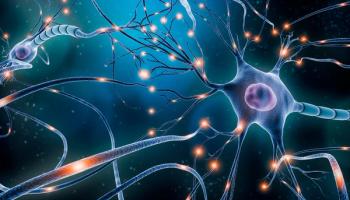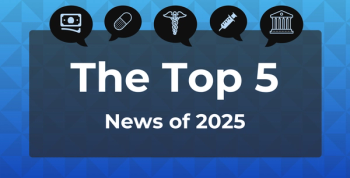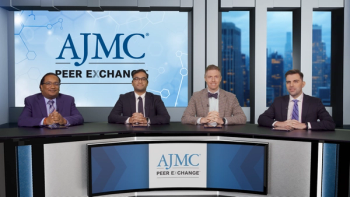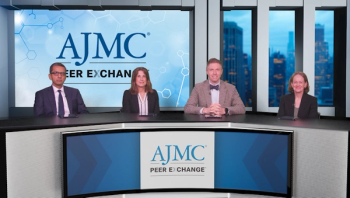
Dr Kami Maddocks: Advances in DLBCL Treatment Despite Challenges in Research
Although B-cell lymphomas can be challenging to study, there have been great advances in treatments in the second-line and later, explained Kami Maddocks, MD, professor of Clinical Internal Medicine, the Ohio State James Comprehensive Cancer Center.
Options for second-line and later treatment of large B-cell lymphoma have really expanded in just the last 5 years, said Kami Maddocks, MD, professor of Clinical Internal Medicine, the Ohio State James Comprehensive Cancer Center.
However, she noted that there remain several areas for improvement, including access to curative therapies and safer and faster ways to administer therapies.
In an interview with The American Journal of Managed Care® (AJMC®), Maddocks also discussed social determinants of health and their impact on treatment and diagnosis of B-cell lymphomas, treatment and research challenges, and more.
AJMC:What are B-cell lymphomas and their pathophysiology in clinical presentation?
Maddocks: B-cell lymphomas are a type of non-Hodgkin lymphoma, which is a blood cancer. It's a cancer malignancy that develops from one of the specific types of white blood cells the lymphocyte. The cancer malignancy can rise from B-cells, T-cells, or natural killer cells. B-cell lymphomas are the most common subtype of non-Hodgkin's lymphoma with about 85% of the non-Hodgkin lymphomas being B-cell lymphomas. So, these lymphomas arise from the B lymphocytes, which are part of the body's immune system and help the body fight infections and develop antibodies.
B-cell lymphomas can have a variety of different presentations, but most patients with B-cell lymphoma are going to present with an enlarged lymph node either something that they can feel or something that can be seen in large lymph nodes on scans. There are a proportion of patients with B-cell lymphomas who will present with what we call B symptoms. This is more common in aggressive types of B-cell lymphomas, and they include daily fevers, drenching night sweats (soak-the-bed type sweating at night), and weight loss (greater than 10% of body weight loss for no other reason). In addition to those, patients can really present with any other symptoms, but extreme fatigue can be a clinical presentation, pain, chest pain, shortness of breath, abdominal pain, nausea, vomiting, and then abnormal blood counts are all other ways that B-cell lymphomas can present.
AJMC:How are B-cell lymphomas diagnosed?
Maddocks: B-cell lymphomas ultimately are diagnosed by a biopsy. Ideally, we have an incision or excisional biopsy for the pathologist to look at. FNAs, or fine needle aspirations, can sometimes be done and direct you to further testing that needs to be done, but most of the time more tissue than that is needed for a diagnosis. A core needle biopsy can sometimes provide enough information. But the pathologist looks at that and based on how the cells look and then they do different testing for markers on the cells—they do something called immunophenotyping and immunohistochemistry to look at proteins that the cells express—they also may perform further testing like different molecular testing and even next-generation sequencing on the tissue to help further subclassify these lymphomas.
AJMC:What are some of the patient risk factors for developing B-cell lymphoma?
Maddocks: In general, age is the biggest risk factor for developing lymphoma. The incidence of the different lymphomas do increase with age with about half of all patients diagnosed with lymphoma being diagnosed at age 65 years or older. The majority of patients will not necessarily have an underlying reason or cause for their lymphoma but there are things that we see that have a higher risk of developing different B-cell lymphomas. Immunodeficiency and chronic immune stimulation can increase the risk of developing a lymphoma. So, patients with autoimmune conditions: for example, rheumatoid arthritis and systemic lupus are at higher risk. Patients with HIV are at a higher risk. Patients who have had solid organ transplant and are on immunosuppressive medications or patients who are on immunosuppressive medications for other reasons are at a higher risk. There's other exposures including prior history of radiation, chemical exposure. We know some veterans and firefighters, for example, have been in situations that they've had an exposure that's led to a diagnosis. Then viruses such as Epstein-Barr virus, human T-cell lymphotropic virus, human herpesvirus-8 virus, and hepatitis C viruses are some of the viruses that can be linked to some of the different types of lymphomas.
AJMC:How common are B-cell lymphomas? Do you have a sense of the incidence and the prevalence in the United States?
Maddocks: If you look at non-Hodgkin lymphoma, it represents 4% of all cancers. Depending on the year it can vary, but it's currently the eighth most common type of cancer in men and women. It's estimated in the year 2023 that there'll be a little over 80,000 cases of newly diagnosed non-Hodgkin lymphoma—again, with about 85% of those being B-cell lymphomas. Again, this can vary by year, but it's estimated that about 1 in 43 men and 1 in 53 women will be diagnosed with non-Hodgkin lymphoma.
AJMC:How might social determinants of health impact the diagnosis and treatment of B-cell lymphomas?
Maddocks: The social determinants of health can impact both diagnosis and treatment of patients with B-cell lymphoma. Some of these factors can lead to delays in the diagnosis of patients, which—particularly for some of the more aggressive lymphomas and even really, for some of the more indolent lymphomas—a delay in diagnosis can lead to a patient who is sicker or has more complications at the time of diagnosis, which can impact their ability to maybe receive certain therapies. It may impact the side effects or toxicities that they have of that treatment. It may even impact the outcome with the therapy, if there's been a long delay in their diagnosis; particularly again, for these aggressive lymphomas.
I think it's important when some of these therapies are hard to access, and they can be expensive, they can have a lot of toxicities and really patients need to be able to understand these therapies, the importance of receiving them, and be able to access the prescribed therapies, as well. Both knowledge and ability of the therapies and the resources in supportive care to receive these therapies appropriately in a timely manner can all impact outcomes.
AJMC:How is the Ohio State University working to address social determinants of health?
Maddocks: Some of the things that we do to try to overcome some of these barriers are the different resources that we help provide patients with. We have patient navigators who help patients access from the time they're scheduled through their treatment journey, patient resource managers which can help both with resources from us and also local resources for these patients, providing educational materials. We have kind of robust financial assistance programs, and then patient experience providers, who are also available to help patients navigate these challenges.
AJMC:How do patients go about finding and accessing these resources that you all are providing?
Maddocks: Before they're even seen here, we obviously have a website but even access to social media, websites, internet can be a challenge [for some patients]. When we schedule patients, we reach out to them and provide them with information. When we see them in the clinics, we identify what sort of resources they have and what sort of resources they don't have, and then through that visit, we're able to connect them with the different resources that they need.
AJMC:In your experience, what have been some of the greatest challenges in researching B-cell lymphomas?
Maddocks: Fortunately, we've seen significant advances in the way we've been able to research and treat B-cell malignancies over the past decade. But looking at research, I think something that can make these diseases challenging to study is that there are numerous different subtypes of B-cell lymphomas, and some of those are very rare. So, in order to study new therapies, oftentimes you have to lump all B-cell lymphomas together, at least, to start to get an indication if some of the therapies are active and then do trials in diseases that they seem to be more active. But some of those trials can take a long time to accrue in less common diseases.
I think one of the other challenges has been that while some of these can have similar pathology and even similar clinical presentation, they may respond very differently to some of the same therapies. The time and the work of figuring that out can be a time-consuming process.
AJMC:Could you expand a little bit more on how treatment independently provides its own challenges?
Maddocks: I think outcomes in survival have certainly improved with our current available therapies. Again, there has been significant progress in the last 5 years. But for aggressive lymphomas, the majority of patients who relapse still will not likely be cured of their disease. For patients with indolent lymphomas—many of these lymphomas are treatable but not curable—they may live a normal lifespan, but they'll have to go through different treatment periods throughout their lifetime. A lot of times, each treatment they have is less effective than the prior treatment they had.
Even highly effective therapies and curable treatments can come with a lot of toxicity, both in the short term and the long term. Some of those therapies might be prohibitive to patients based on the toxicities or they may lead to long-term complications for patients. So, you kind of cure or solve one problem, but potentially create another through toxicity. Some of our treatments are highly specialized and not able to be accessed by all patients because of the location or the center that they need to be able to get to in order to receive those.
Lastly, I think we have to talk about financial toxicity. These newer therapies are not cheap and so there is a financial burden that comes for patients be it a very expensive one-time therapy or receiving a chronic oral therapy that they're on for several years. That's certainly a challenge for patients.
AJMC:How often do patients with large B-cell lymphoma become refractory or relapsed on frontline therapy?
Maddocks: Our knowledge with the current standard frontline treatment is that large B-cell lymphoma is cured about 60% of the time or a little bit higher. So, 60% or a little more of patients who are diagnosed will be cured with their frontline chemoimmunotherapy for large B-cell lymphoma. That leaves about 40% of patients who will either be refractory to or relapse after achieving an initial response to their frontline treatment. The majority of those patients will have earlier relapse so the majority of patients who do relapse will relapse within the first 2 years of completing their initial chemotherapy. Again, the majority of those actually within a year.
AJMC:What outcomes are associated with that? Obviously, that's difficult if you've got that 40% who are refractory or relapse. What happens and what are the overall survival rates?
Maddocks: Yeah, so this is actually a changing treatment landscape, but it's thought with our currently available therapies that around 30% of patients may be cured with relapsed or refractory disease. Now, a lot goes into that: are the patients candidates for treatment at relapse or when they're found to have refractory disease? If there are candidates, is that a potentially curative treatment therapy? Then if the second-line treatment doesn't cure them, what are they able to receive after that?
AJMC:You said that about 30% maybe cured. Are others on long-term treatment with secondary treatments or how does that end up working out?
Maddocks: It can be variable. For patients who are candidates for chimeric antigen receptor (CAR) T-cell therapy—either because they have refractory disease or relapsed within a year or because they're not candidates for aggressive chemoimmunotherapy and stem cell transplant if they have later relapses—we know from the current available data we have that patients who are able to access that probably about 35% to 40% will have long-term disease-free survival.
There are other therapies that are potential: both time-limited therapies and then therapies that can be continued until progression. Most of those therapies, at this current time, are thought to be more palliative or not known to be curable. Although we are seeing some longer follow-up with some of those therapies that there is a small percentage of patients who will remain in remission at longer follow-up. So there is a potential that some of these patients may be cured of their disease.
AJMC:What are the recommended treatment options? What is available for second-line therapy and beyond in large B-cell lymphoma?
Maddocks: The treatment options really have expanded in the last 5 years. Historically, if a patient relapsed prior to the availability of CAR T-cell therapy, the only known curative therapy was giving them in a second-line chemotherapy regimen, which is often referred to as salvage chemotherapy, and then taking them to an autologous stem cell transplant. In the current era, that was shown to have an event-free survival of about 20% at 5 years. So, many patients either weren't a candidate for that type of therapy or didn't respond to the salvage or could relapse after the transplant.
CAR-T cell therapy was initially approved for patients who either didn't respond to their second-line chemotherapy or relapsed after transplant. In that third-line or later setting, it was shown to have durable responses in about 30% to 40% of patients. It has now been moved into the second-line setting and has an approval for patients who either do not respond to frontline therapy or relapse within a year of receiving that therapy or for older patients or patients with comorbidities who are not candidates for an autologous stem cell transplant. Currently, that looks like probably about 40% of patients will have durable remissions in that setting, and it's felt to be potentially curative therapy in that setting.
For other patients, there are a lot of challenges to CAR T-cell therapy. Some patients are unable to access the therapy, for some patients it's toxicity, for some patients it's the logistics of receiving the therapy, and so there are other options for treatment. There's a regimen called tafasitamab and lenalidomide which is a CD19 antibody in combination with an oral immunotherapy. This has FDA indication for the second-line or later setting and it is probably one of the best choices for patients who are not going to be able to access a CAR T-cell therapy who have relapsed disease.
The combination of bendamustine, rituximab, and polatuzumab is approved really in the third-line or later setting but also has a lot of data in the second line setting. Polatuzumab is an antibody-drug conjugate targeting CD79B, and this regimen is an option in the second-line or later setting. Again, a small percentage of patients that had been treated on these trials continued to be in a remission greater than 2 years, and so there's some suggestion that there are patients who may have durable responses with this regimen. I will mention that sometimes this regimen is used as a third-line therapy or as a bridge to CAR-T cell therapy, and then often the bendamustine is left out of the treatment.
Loncastuximab is the CD19 antibody-drug conjugate approved in the third-line or later setting. Bispecific antibodies are not approved in diffuse large B-cell lymphoma at this time, but it is anticipated in the future that these might be approved options and have been very successful in clinical trials. Speaking of clinical trials, that's always a great option for patients if they are eligible and can access clinical trials.
Then there are some other therapies that have been shown to have activity in select populations and can be accessed, including Bruton tyrosine kinase inhibitors, the CD30 antibody-drug conjugate brentuximab in patients who have CD30-positive disease. And then there's an oral therapy called selinexor that is approved, although is less commonly used just due to challenges.
AJMC:What are the largest unmet needs in relapsed or refractory large B-cell lymphomas?
Maddocks: There are still several areas where we can improve. I think just improving access to the curative therapies we have—access to CAR T-cell therapy can be a challenge, because it requires a specialized center because of the toxicities. Improving on these therapies, whether it be newer therapies, less toxic therapies in this setting, the ability of more patients to access it, similarly effective therapies with more accessible products, safer ways to administer them, and faster ways to administer them. Off-the-shelf or allogeneic products is one area that's being investigated.
For patients who are not candidates for CAR T-cell therapy or don't have access, we still have ways to improve the therapeutic options available to these patients. Then for patients who do receive CAR T-cell therapy and don't respond or relapse after CAR T-cell therapy, there's still a need for improved therapies in this setting.
AJMC:What are you working on in the management of B-cell lymphomas that you're really excited about that you'd like to share?
Maddocks: Not just specific to me, but some of the exciting things going on in B-cell lymphoma include some of the bispecific antibodies, which are not approved, but those therapies alone or in combination are very exciting because they seem to have high efficacy, but don't appear to have the same toxicities that CAR T-cell therapy has, and it will be more accessible to more patients. I also think that they'll be able to be combined with other therapies in some of the other B-cell lymphomas, moving targeted therapies into the frontline setting and using combination targeted, and immunotherapy and eliminating chemotherapy is exciting.
Then looking some of the different things like using minimal residual disease or circulating tumor DNA to help us make treatment decisions, whether it be escalating therapy or stopping therapy or intervening early are things that are exciting future aspects of B-cell lymphoma treatment.
Newsletter
Stay ahead of policy, cost, and value—subscribe to AJMC for expert insights at the intersection of clinical care and health economics.









































